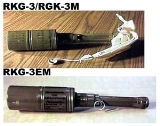
RKG-3 anti-tank grenade
Overview
Russia
Russia or , officially known as both Russia and the Russian Federation , is a country in northern Eurasia. It is a federal semi-presidential republic, comprising 83 federal subjects...
n series of anti-tank hand grenades. It superseded the RPG-43
RPG-43
The RPG-43 was a high explosive anti-tank hand grenade used by the Soviet Union during the Second World War. It entered service in 1943, replacing the earlier model RPG-40. The RPG-43 used a shaped charge HEAT warhead, whereas the RPG-40 used the simpler HE warhead...
, RPG-40
RPG-40
The RPG-40 was an anti-tank hand grenade developed by the Soviet Union in 1940. Its anti-tank capability came from blast effect produced by the detonation upon contact of 760 grams of explosive contained in it. This effect enabled about 20 mm of armour to be penetrated, and secondary damage,...
and RPG-6
RPG-6
The RPG-6 was a Soviet anti-tank hand-grenade operating on the shaped charge principle, developed during World War II...
series of grenades.
RKG stands for Ruchnaya Kumulyativnaya Granata (Handheld Shaped Charge
Shaped charge
A shaped charge is an explosive charge shaped to focus the effect of the explosive's energy. Various types are used to cut and form metal, to initiate nuclear weapons, to penetrate armor, and in the oil and gas industry...
Grenade). When the pin is pulled and the grenade is thrown a four-panelled drogue parachute
Drogue parachute
A drogue parachute is a parachute designed to be deployed from a rapidly moving object in order to slow the object, or to provide control and stability, or as a pilot parachute to deploy a larger parachute...
is deployed by a spring. This parachute stabilizes the grenade in flight and ensures that the grenade strikes the target at a 90 degree angle, maximising the effect of the shaped charge.

